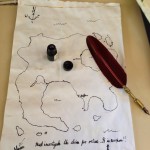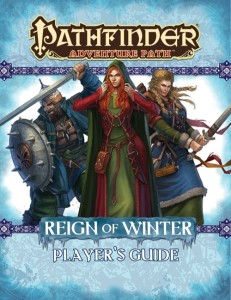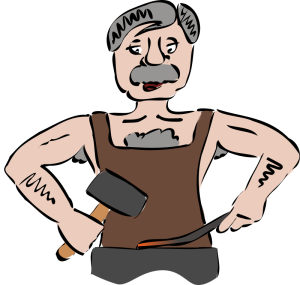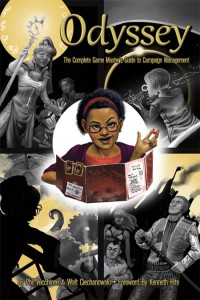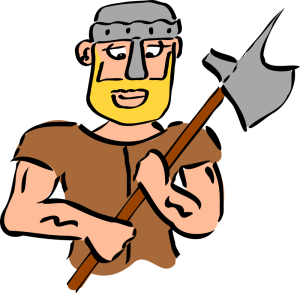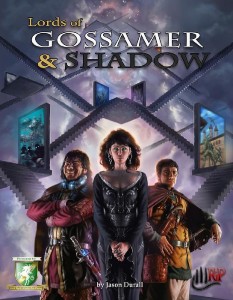 Of recent times I have been spending a good deal of my blogging time creating non player character (NPC) profiles for the Lords of Gossamer and Shadow RPG over on my blog. Due to this I have had a lot of comments from people regarding the way I make these NPC’s from the rules and how I have applied them right through to the themes I have used to create them. One comment in particular caught my eye this weekend and got me to thinking a little more in depth about the process I use to create all NPC’s in all of the games I run.
Of recent times I have been spending a good deal of my blogging time creating non player character (NPC) profiles for the Lords of Gossamer and Shadow RPG over on my blog. Due to this I have had a lot of comments from people regarding the way I make these NPC’s from the rules and how I have applied them right through to the themes I have used to create them. One comment in particular caught my eye this weekend and got me to thinking a little more in depth about the process I use to create all NPC’s in all of the games I run.
The comment was made to the FATE Core community on Google Plus and mentioned as an aside that the work I had been doing on my NPC’s had highlighted the importance of gear, magic items, allies and all surrounding material as a reflection on the NPC itself. This obviously was not a new concept to me as it is true, I was making the items, creatures, domains etc. all be reflective of the NPC as a whole. This is an important concept when building an NPC. If you want the players to accurately demise the archetype of the character, you use all of the character, not just their personality to reflect this. If I am after a big bruiser barbarian in Pathfinder I am unlikely to dress him in ceremonial robes of a peace god and arm him with a rapier. It is more likely that he will appear in the hide armor of a T-Rex (that he killed) and wield a massive two handed vorpal battle axe or something similar that evokes the reaction of the big bruiser barbarian with the players.
It sounds simple enough. Some might even say it is really a no-brainer that you use this method to create flavor and evoke feelings from players. But it is not in actuality all that easy when you are working with a complex system such as Pathfinder for example. The reason this becomes a much more complex problem is based on the complexity of the system. Let me take the big bruiser barbarian from above and explore the idea a little further.
Let us suggest our players are around 7th level and the big bruiser barbarian (henceforth known as Bob) is going to be their nemesis from say their current level through to around about when they are level 12. Bob is the mid-range foe in an adventure of Cthulhu worshippers the players are trying to shut down. If we take that description and think about our mate Bob for a moment I would suggest that we put him at 13th or 14th level as a Barbarian class, or CR 12 to 13 for GM speakers. From a simple building of the class perspective we find this is going to involve 3 ability score increases (easy – Strength or Con depending on starting stats), 8 feats (8 because Bob is a human. All the best monsters are human. This is a tricky one though because feats are very complex) and 6 rage powers (also not a simple solution based on the number of powers available).
 We are really just dealing with the core build of the character here and we are already frowning and reaching for multiple rulebooks. Stats are an easy decision because any good Barbarian needs to be hale and healthy as well as capable of lifting a small moon should the need arise. But then we move on to feats and the complexity involved in those decisions can be a bit overwhelming. If you look at the core books alone (Core Rulebook, Advanced Players Guide, Ultimate Magic, Ultimate Combat, Ultimate Campaign, Advanced Race Guide, Mythic Adventures, Inner Sea World Guide) you can easily be overwhelmed by the number and complexity of Feat choices that you need to make. Of course as a fighter class we would expect to see Improved Initiative and Toughness as well as some weapon specific things like Weapon Focus, Improved Weapon Critical etc. but really there are thousands of options here and even more combinations that could be used so it really is up to personal knowledge and choice here.
We are really just dealing with the core build of the character here and we are already frowning and reaching for multiple rulebooks. Stats are an easy decision because any good Barbarian needs to be hale and healthy as well as capable of lifting a small moon should the need arise. But then we move on to feats and the complexity involved in those decisions can be a bit overwhelming. If you look at the core books alone (Core Rulebook, Advanced Players Guide, Ultimate Magic, Ultimate Combat, Ultimate Campaign, Advanced Race Guide, Mythic Adventures, Inner Sea World Guide) you can easily be overwhelmed by the number and complexity of Feat choices that you need to make. Of course as a fighter class we would expect to see Improved Initiative and Toughness as well as some weapon specific things like Weapon Focus, Improved Weapon Critical etc. but really there are thousands of options here and even more combinations that could be used so it really is up to personal knowledge and choice here.
Once we are past that we are then faced with a similar customization problem with barbarian rage powers. You could take an archetype suggestion and build Bob from that perspective or do you try to customize him yourself. Certainly there are far less options than feats in this regard but getting the right balance can be a difficult thing entirely. The good news is that once we are at this point we have a naked Bob with all of his personal functions dealt with. This is Bob when he wakes up of a morning and Bob when he goes to bed at night. But we need to look at the external things to Bob and how they reflect Bob to the external world.
What I am speaking about specifically is Bob’s equipment, allies, pets, magical items etc. This is what anyone wandering down the street who runs into Bob has to look at and reflect on to decide how they view Bob. Although most of the material that we have covered is how good Bob is, this is the stuff that we can flavor Bob with for the true purpose of role playing him in our adventures. We want the players to fear Bob (rightfully so when they first encounter him) and have him a recurring threat to the players for a good portion of the campaign.
But of course we are back to the same problem here as we were with feats. There is soooo much to choose from. If we want normal equipment we have the Ultimate Equipment guide, if it is magical then we are staring again at multiple (at least 4) books for the information. But each piece that we add to the character builds him up. A GM with a photographic memory will do this very well as they will remember the precise items they need but this search can take a long time for those of us that start to read magic items one at a time to get the right match.
From the above six paragraphs I have given you a basic understanding of the complexity that can come of making a simple NPC for a game. The larger the ruleset the more likely you are to find the complexity shoots through the roof. I actually intend to do a series of Pathfinder NPC’s for my blog in the near future and I already know that I will be spending a lot more time on them because of the complexity of the system. Believe me, complexity of a system does not necessarily mean that you will end up with better NPC’s overall either. The NPC’s that I have worked up for the Lords of Gossamer and Shadow have such a small rule base to choose from but the rules are really aimed at storytelling conventions and thus each is very different from one another, even those that have a similar focus.
 So back to how we make our NPC reflective of what we want. The very first thing is have the concept. We have Bob the big barbarian bruiser and we want players to be fearful of him. Why are they afraid of him? Is it because he is deadly, or just intimidating? I want to go with an intimidation style for him so I think about how that looks. T-Rex armor mentioned before would be cool, but what is cooler and scarier looking is a suit of magical bone armor! Perhaps the bones of a T-Rex instead. His weapon needs to be large and differentiate him. When I want a weapon that stands out I normally choose a flail, and in this case I think that is what I will do. A big double headed flail with spiked heads that has some kind of magical enchantment. I would like an amulet of bone or something similar, but he already has the bone armor, so perhaps we work on a magical amulet (probably natural armor or something similar) fashioned from the shriveled T-Rex’s heart? Take the above three items and apply them to a mental image right now. He is an intimidating guy. Now, just for flavor add the crisscrossing of many scars to his exposed body and a scar that starts at his right brow and marks its way all the way down to his left cheekbone. Nice.
So back to how we make our NPC reflective of what we want. The very first thing is have the concept. We have Bob the big barbarian bruiser and we want players to be fearful of him. Why are they afraid of him? Is it because he is deadly, or just intimidating? I want to go with an intimidation style for him so I think about how that looks. T-Rex armor mentioned before would be cool, but what is cooler and scarier looking is a suit of magical bone armor! Perhaps the bones of a T-Rex instead. His weapon needs to be large and differentiate him. When I want a weapon that stands out I normally choose a flail, and in this case I think that is what I will do. A big double headed flail with spiked heads that has some kind of magical enchantment. I would like an amulet of bone or something similar, but he already has the bone armor, so perhaps we work on a magical amulet (probably natural armor or something similar) fashioned from the shriveled T-Rex’s heart? Take the above three items and apply them to a mental image right now. He is an intimidating guy. Now, just for flavor add the crisscrossing of many scars to his exposed body and a scar that starts at his right brow and marks its way all the way down to his left cheekbone. Nice.
By considering the character first and what you want to achieve you can peel away some of the complexity. Make the weapons and armor be custom magic items and you can build them how you want. Decide what you want in a magical item (such as the amulet) and then backwards fashion it. An amulet of natural armor is normally made from bone or beast scales. I don’t care, lets make it a T-Rex heart, it is all good!
Regular equipment is normally not that flavorable. Of course you can make it a little more intense with description but this tends to delude the player into thinking things are magical (if it has a description it is magical to a player) so it is best not to be too descriptive of other material. But then consider if they ride a dragon (Bob doesn’t but wouldn’t it be cool if he did!) or have a troll hound as a pet. What about his generals that surround him? What are they like? Are they strong and confident or sniveling and scared? All of these factors build up an impression for the players.
The next thing to do is to plan how the players come across Bob. It is much better to layer an NPC onto the players. The first time they meet Bob have him making off with a magical treasure they were sent to collect. He is by himself and he fights and defeats them making off with the treasure. Then the players do some surveillance and to their surprise they find him at the heart of the enemy camp, seemingly surrounded by sniveling lieutenants, suggesting he may be of importance.
This layering of the NPC builds the tension and the sweet success the players will feel as they finally defeat him after a string of interrelated adventures. You use other NPC’s and the NPC’s gear to be reflective of the character as a whole. That way they do not necessarily need to talk to Bob to realize he is the big bruiser barbarian. Of course it is nice to work against archetype once in a while (e.g. Bob actually sympathizes with the players and becomes an ally in the long run) but these twists should be used rarely or otherwise the players will always expect the unexpected from your NPC’s and rightfully so.
Crafting an NPC is an important role and I hope the points above help you to consider a few things you may not have in the past. Simply getting the class and stats right is only one half of the job, if that. Players will judge based on how the NPC looks and how they act. They rarely know that Bob has Strength 22 but they do know he just cleaved that Hobgoblin right in two with one hit. Consider your NPC’s from every angle and make sure they accurately fit the bill that you need for your game on game night. Keep rolling!
Mark Knights is 39 year old guy living in a small rural town called Elliott in Tasmania, Australia. I have been role playing since I was 11 years old playing the original versions of Dungeons and Dragons, MERP, Elric, Dragon Warriors and the like amongst other genre games. I played D&D 2nd Edition through the 90′s but I ran Earthdawn for my fantasy setting and loved it as a GM. When 3rd Edition came out for D&D I tried it but found it too heavy on rules. I ignored the 3.5 edition of DnD in favour of Earthdawn (big mistake) as I thought it was just a money spinner. When 4th Edition DnD came on my players and I gave it a red hot go but hated what it had dumbed the game down to be. On a trip to Melbourne to buy some 4E stuff from a hobby store an old mate of mine pointed me at Pathfinder and in a Fantasy setting I have never looked back.







